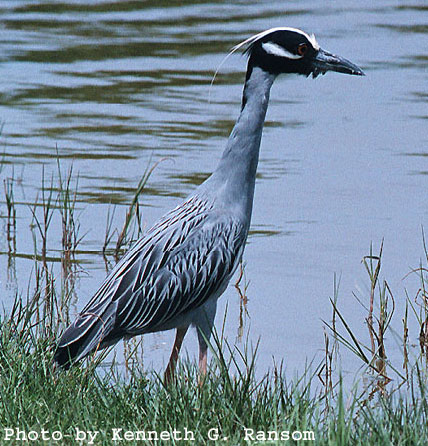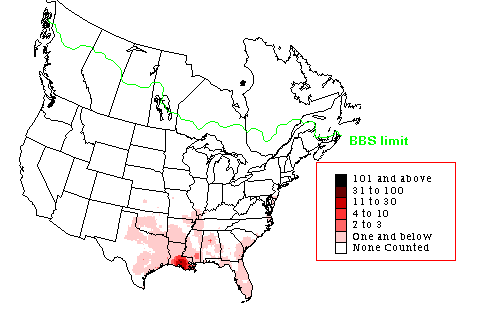Habitat
 Yellow-crowned
night herons are waterbirds, so they occupy wetlands, costal
regions, and wet inland environments near lakes and rivers
(Bagley and Grau 1980). Most American yellow-crowned night heron
populations reside in the southeast region of the continental
U.S. (United States Forest Service 2004). Even so, populations
of Nyctanassa violacea have been spotted throughout
different inland regions such as Wisconsin (Wyman and Wyman
1941), Kentucky (Suthard 1926), and Illinois (Bellrose 1938).
These herons inhabit environments outside the United States as
well; populations of the yellow-crowned night heron have been
studied in Brazil (Martínez 2004) and Bermuda (Wingate 1982).
Though these night herons have been found in different regions
and continents, they are stenotypic birds that thrive in a
limited habitat range (Martínez 2004).
Yellow-crowned
night herons are waterbirds, so they occupy wetlands, costal
regions, and wet inland environments near lakes and rivers
(Bagley and Grau 1980). Most American yellow-crowned night heron
populations reside in the southeast region of the continental
U.S. (United States Forest Service 2004). Even so, populations
of Nyctanassa violacea have been spotted throughout
different inland regions such as Wisconsin (Wyman and Wyman
1941), Kentucky (Suthard 1926), and Illinois (Bellrose 1938).
These herons inhabit environments outside the United States as
well; populations of the yellow-crowned night heron have been
studied in Brazil (Martínez 2004) and Bermuda (Wingate 1982).
Though these night herons have been found in different regions
and continents, they are stenotypic birds that thrive in a
limited habitat range (Martínez 2004).
Nyctanassa violacea prefer to inhabit wet, tropical, and
coastal environments (Wingate 1982) so they can feed in shallow
bays and shores (Watts 1988). Foraging in these environments
gives the yellow-crowned night herons considerable access to
crab (Martínez 2004), their main food source (Wingate 1982;
Riegner 1982). Yellow-crowned night herons possess structural
and behavioral adaptations for preying on crustaceans, so their
habitat must be rich in crab to reflect their dietary needs and
hunting styles (Rienger 1982). In fact, Nyctanassa violacea
are so dependent on crustaceans, their residence areas show a
strong correlation with high population levels of crab; other
birds with a wide range of prey do not choose habitats in
correlation to specific prey populations (Martínez 2004).
Another benefit to living near tropical bays is the ability to
feed during low tide. When large areas of the bay are exposed
during low tide, yellow-crowned night herons swoop in to hunt
unprotected crab (Watts 1988). However, not all foraging
locations of Nyctanassa violacea provide the luxury of
low tide, so the heron has developed flexible hunting
strategies. One technique, the “sit-and-wait” strategy allows
yellow-crowned night herons to hunt without expending a lot of
energy (Riegner 1983).

Because of the abundance of aquatic life, yellow-crowned night
herons often have to share their habitat with other hunting
waterbirds. The scarlet ibis, for example, shares a habitat with
the yellow-crowned night heron in parts of South America. Unlike
the night heron, the scarlet ibis is flexible in prey and will
hunt on a wide range of organisms besides crab. Though the
scarlet ibis and yellow-crowned night heron share an
environment, these two birds probably don’t experience much
competition for food (Martínez 2004).
Figure 1.1. This map shows the concentration of yellow-crowned
night heron populations on the continental U.S. (USGS).
Though yellow-crowned night herons are found in a variety of
different regions, they are heavily adapted to a specific wet
environment. The main reason for focusing on this type of
habitat is the night heron’s need for a high supply of crab.
For more specifics on yellow-crown nigh heron habitats, visit
the
Cornell Lab of Ornitololgy.These animals have developed specific strategies and adaptations
for hunting crab, and are usually able to acquire their supply
with little competition. In addition to adapting to this
specific environment, the yellow-crowned night heron has evolved
to posess characteristics in
form and function to facilitate
survival.